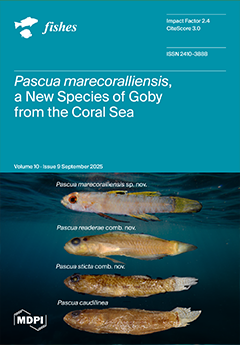This study evaluated the effectiveness of essential oil from
Aloysia citrodora (EOAC) (48% citral and 19% limonene) for use in anesthesia and simulated transport of tambaqui (
Colossoma macropomum) juveniles at two cargo densities (CDs). Concentrations of 0 (control), 10, 25, 50,
[...] Read more.
This study evaluated the effectiveness of essential oil from
Aloysia citrodora (EOAC) (48% citral and 19% limonene) for use in anesthesia and simulated transport of tambaqui (
Colossoma macropomum) juveniles at two cargo densities (CDs). Concentrations of 0 (control), 10, 25, 50, 100, 150, 200, and 250 µL EOAC L
−1 were tested for use in anesthesia induction and recovery, while 0 (control) and 20 µL EOAC L
−1 were tested for their effects on the ventilatory rate (VR) and during 6 h simulated transport at a low CD (LCD, 65 g L
−1) and standard CD (SCD, 130 g L
−1). Fish were anesthetized at EOAC concentrations above 50 µL L
−1, with the optimal anesthesia (141.83 s) and recovery times (160.00 s) at 250 µL L
−1. The water unionized ammonia was lowest in the EOAC-LCD group. Using 20 µL EOAC L
−1 during transport minimized changes in the hematological parameters (erythrocytes, hemoglobin, hematocrit, total leukocytes, and heterophils) and reduced the liver aspartate aminotransferase activity at both CDs. Transport at an SCD, regardless of EOAC use, increased the plasma glucose, hepatic glycogen, and alanine transaminase activity. The VR was higher with 20 µL EOAC L
−1 than in the control group. In conclusion, our findings confirm that 20 µL EOAC L
−1 can effectively be used to transport tambaqui for up to 6 h without impairing fish health.
Full article





